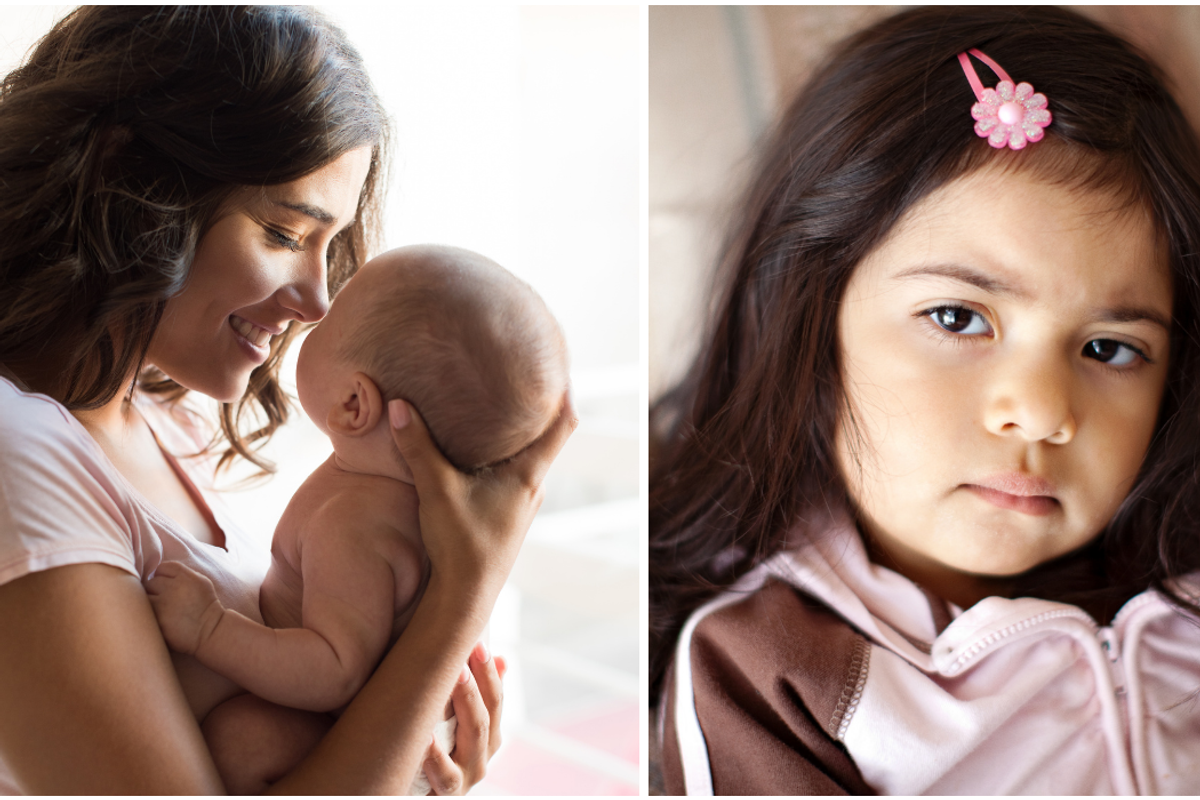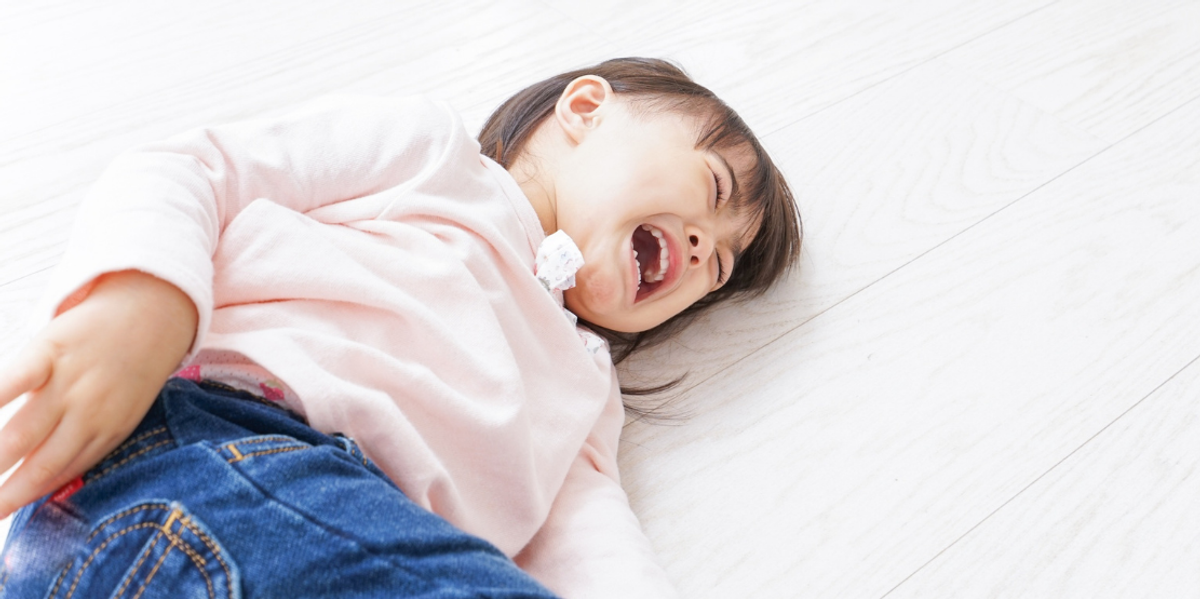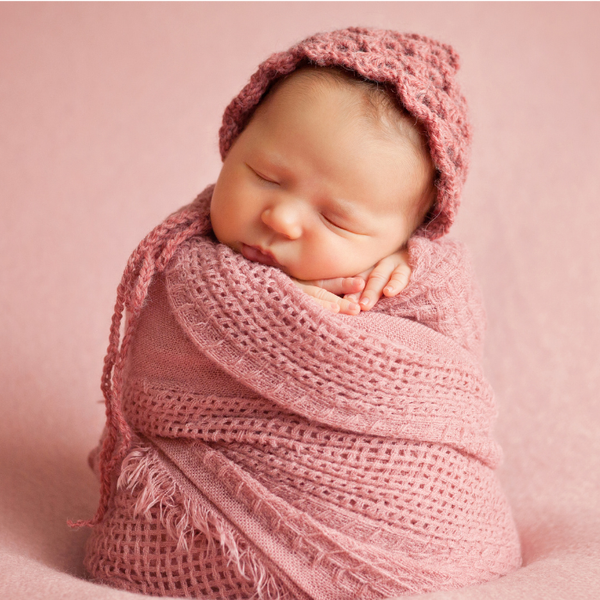Parents reveal 8 genius hacks for introducing toddlers to newborns without jealousy
Lucie Fink, shared her family's tips for introducing toddlers to their newborn baby siblings without sparking jealousy.

A little effort can go a long way.
Welcoming a newborn into the family is usually a magical occasion. There are pictures to be taken; first moments that must be documented. But for a child, this can be an unsettling experience. One day, it’s just them and their two doting parents. Then, out of nowhere, a tiny baby appears and starts hogging all the attention? How unfair.
Fortunately, there are several strategies parents can use when introducing a toddler to a newborn to minimize feelings of jealousy. In a viral TikTok video, Lucie Fink—a mom of two and host of The Real Stuff podcast—shared how she and her husband successfully introduced their baby girl to Milo, their toddler son, while keeping any potential jealousy at bay. Since it was posted in early February 2025, the video has been met with overwhelming positivity online, garnering 1.6 million likes and over 11 million views.

“As a child development major… YES.”
The video begins with Lucie, still in her hospital gown, welcoming her husband and son into the postpartum unit. “I got a balloon for you!” exclaims her toddler. Using strategically placed overlaid text, she details the 8 techniques she and her husband used while introducing their toddler to his newborn baby sister, including adding photos of him to the baby’s bassinet (to make him feel special and included) and transferring the baby to Milo’s arms calmly and intentionally when he was ready and asked to hold her.

Sibling rivalry isn’t inevitable
While sibling rivalry is normal (according to child specialist Alexander K.D. Leung, it “occurs between most, if not all, siblings to varying degrees” and “is as old as mankind”), unmanaged competitive feelings in childhood can lead to psychological problems later in life. “A child who feels threatened of losing parental affection and love may react with rejection or hate towards a new sibling who is often perceived as an ‘intruder,’” Leung notes in his 1991 research article. “This is more common if the child feels insecure as a result of overprotective, excessive domination, parental impatience, or excessive discipline.”
Sibling rivalry begins here, at the onset. Even parents who handled their first child easily may be surprised by the new, constantly shifting dynamics a second baby can bring. Although you can prepare a child for months, even years, to become an older sibling, until they experience it, they won’t actually know what it feels like. Suddenly, it seems like their emotional and physical needs are in direct competition with the baby’s: Who gets their parents’ attention? Who deserves to be fawned over? These changes are real—and scary!—for a child and can cause them to act out or revert to previously outgrown baby behavior, according to the Association of Child Psychotherapists. They write: “It must be remembered that it is the parents who choose to have another baby, not the older sister or brother. They have no say in the matter, and what is, to you, largely a source of happiness may be nothing of the sort to your child.”

8 ways to reduce jealousy, according to Lucie Fink
When the child first enters the room, don’t mention the baby. Instead, focus on them. In the video, we see Lucie greet her son Milo solo, with the baby nearby but out of sight. Although he’s excited to meet her, Lucie stays focused on her son, making direct eye contact and creating a special one-on-one moment just for them.
Place the baby off to the side in a bassinet, so your arms are free to cuddle the other child. At first, Milo is focused solely on the baby, but with his mom’s loving invitation, he jumps into the hospital bed next to her. “Get cozy!” she insists, and the two burrow beneath the plush blanket together.

Arrange photos of the older child in the baby's bassinet to remind them that they're special and included. "Look, she was looking at pictures of you all day," Lucie says warmly, picking up a photo from the bassinet to show Milo. Several large photos of him are prominently displayed around the baby—a simple yet powerful symbol of their new beginning as siblings.
Transfer the baby calmly and intentionally, waiting for the older child to be ready and to specifically ask to hold them. Don’t rush or force the process. “The preparation of existing children for a new sibling helps to reduce sibling rivalry,” reminds child specialist Alexander K.D. Leung. “Patience, love, understanding, common sense, and humor are important parental skills necessary to minimize sibling rivalry.” Once settled and secure next to his mom, Milo puts out his arms excitedly and asks: “Can I hold?” As his father lowers the baby into his arms, Lucie chimes in with assurance, “Oh, you got her.” Soon, the two are bonding for the first time, and Milo holds his baby sister close.

Family hugs signify that you’re a unit. Before long, the dad exclaims, “Family hug!” and the four embrace. Instead of Milo feeling like an outsider, the tender moment reflects a carefully arranged message: “We’re all excited to welcome the fourth member of our family.”
Let the older child hold the newborn at home, but only when they want to. “We try not to pressure him or continually ask if he wants to,” writes Lucie. Finding the perfect balance is key: while it’s important to involve your toddler in baby-related tasks, don’t demand too much of them.

Don’t blame the baby for not being able to attend to their needs. According to BetterHelp, “When a child feels like they must compete for their parent’s love and attention, this feeling might lead to animosity, which can increase over time.” Especially during this transition time, elder children must be reminded that they’re also a priority. Instead of saying, “I need to take care of the baby” or “The baby needs this right now,” Lucie recommends switching up the responsibility. Try: “Daddy’s just finishing up!” or “Mommy will be right there.
Include them in the caretaking process. Lucie writes that with her son, they tell him that it’s “the whole family’s job to work together to care for our weakest member.” Not only will your toddler love having something to do, but simple tasks—asking them to pass you a bottle during feeding time or to please entertain their younger sibling in the backseat when they're fussy—will give the older child a sense of purpose and help them feel more involved.

Why it’s important to put your toddler first sometimes
While a new baby demands constant attention—and sometimes, your sleep-deprived brain goes on auto-pilot—taking time to acknowledge your toddler’s big feelings is crucial. Even the smallest gesture, like asking for help instead of demanding it, can help build the foundation for a long-lasting, harmonious relationship between siblings. However, if left unaddressed, sibling rivalry can manifest as verbal or physical attacks, persistent demands for attention, or as regressive phenomena” in children. As adults, that behavior can morph into open aggression, cruel manipulation, or avoiding each other altogether.
A study about family dynamics conducted at Cornell University found that after multiple interviews with mothers and their adult children, only 15% of children felt their parents treated them equally compared to their siblings. The research also showed that siblings develop stronger bonds when parents consistently work to treat them fairly and give equal attention to each child.
While parenting often feels unpredictable, Lucie Fink and her husband (along with Milo and the new baby!) demonstrate that small, thoughtful efforts toward your firstborn can make an enormous difference. Watch her entire parenting video below.

